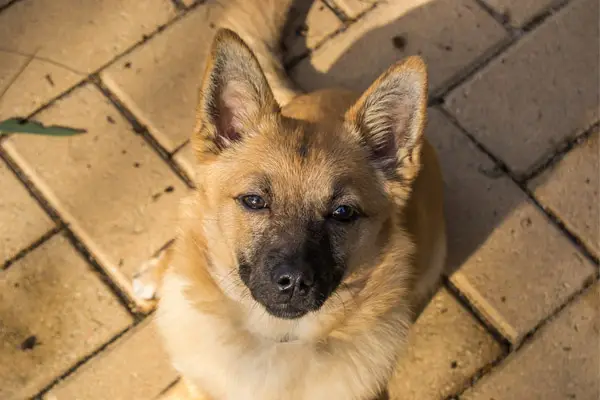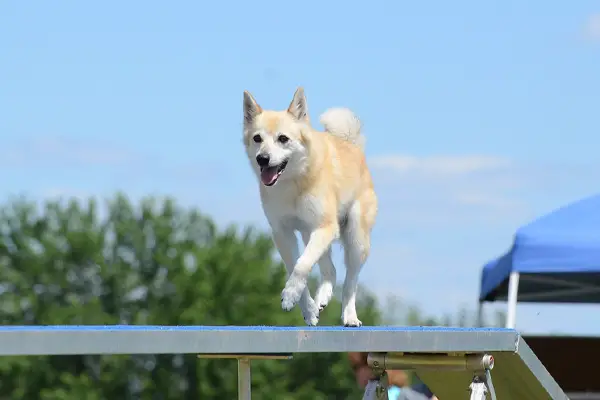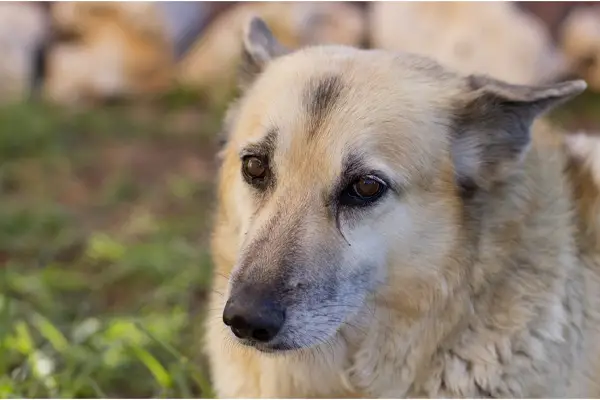Norwegian Buhunds are medium-sized dogs that usually stand at a height of 18.5 inches maximum. The Norwegian Buhund is a spitz-type dog that features prick ears, a fox-like face, tails that curve at the back, and thick coats that come in wheaten or black colors.
Norwegian Buhunds are known to be alert and energetic dogs that need plenty of exercise. If you are active and love the outdoors, then these dogs would be perfect companions. These dogs love people, and they would be best to stay indoors and be with family.

Norwegian Buhund Statistics
| Dog Breed Group | Herding |
| Breed Size | Medium |
| Height | 17-18.5 inches (male); 16-17.5 inches (female) |
| Weight | 31-40 pounds (male); 26-35 pounds (female) |
| Lifespan | 12-15 years |
Norwegian Buhund Ratings
| Energy level | |
| Exercise needs | |
| Requires attention | |
| Playfulness | |
| Trainability | |
| Shedding | |
| Grooming | |
| Friendly with family | |
| Friendly with kids | |
| Friendly with strangers | |
| Friendly with other dogs | |
| Prey Drive |
Norwegian Buhund History
Norwegian Buhunds are ancient dogs whose true origin was never recorded. They are believed to have been in Norway for centuries and have accompanied Vikings as far back as 900 AD. The remains of Spitz-like dogs were found in Viking graves, which determines that they were highly-prized dogs.
The modern Norwegian Buhunds were developed in the Rogaland region in Norway. They were mainly used as versatile farm dogs with two main duties: guarding families, flock, and farms, and herding livestock such as sheep, cattle, and reindeer.
Although these dogs have been around for centuries, it wasn’t until the 1920s when they were first exhibited in a dog show in Norway. By 1939, a breed club was founded.
As early as the 1980s, the breed was imported to the US. However, it took longer for the American Kennel Club to recognize the breed in 2009.
It currently ranks 165th as the most popular dog breed in the US. They are still considered rare in the US, but they are still known to help farmers in Norway as an all-around working dog.

Norwegian Buhund Temperament
Norwegian Buhunds are confident, smart, and perceptive dogs. They are happy-go-lucky and playful dogs that love to run around if you let them.
You must give these dogs lots of physical and mental stimulation. This makes them an excellent fit for active families who can give him opportunities to run, hike, bike, and play.
They love people, and they most especially love attention and companionship. Include him in your family activities. They are not the dogs that you can leave alone without any form of entertainment. If you do, then they can become destructive.
These dogs are loving and affectionate with their owners. They also make excellent playmates for children. However, toddlers would need close supervision. With their herding instincts, they might chase around smaller pets in the house or even your children.
Norwegian Buhunds can be polite or wary when it comes to strangers. They make excellent watchdogs, so expect them to bark when they sense something suspicious.
Training can be quite challenging as they have independent tendencies. You need to be consistent and firm if you want this dog to follow what you want instead of the other way around. Socialization should also start at an early age to make them more well-rounded.
Care Requirements
- Nutrition: Norwegian Buhunds don’t have special dietary requirements. All you need is to serve them high-quality meals every day that consists of an outstanding balance of essential nutrients – proteins, fats, carbohydrates, vitamins, and minerals. You can get these from high-quality ingredients. Animal meat, such as lamb, beef, or poultry, is an excellent source of protein. You can add whole grains or sweet potatoes for carbohydrates, while fish and chicken oils are excellent sources of fats. Add fruits and vegetables on their meals, too, for vitamins and fiber. If you’re buying dog food or dog treats, choose the premium quality ones. Check the label and make sure that it doesn’t contain fillers, additives, and by-products as these have low nutritional value. Stay away from any ingredient that your dog is allergic to. Another thing you should watch out is the number of calories you feed them in a day. If you’re unsure, ask your vet for advice, and he can make you a guide or feeding requirements specific to what your dog needs.
- Grooming: Norwegian Buhunds have smooth double coats that shed seasonally. They are not high-maintenance dogs and will only need weekly brushing to remove loose hair and keep shedding to a minimum. Although during the shedding season, you may need to brush the coats two to three times a week. Baths can be given occasionally as these dogs don’t release much odor even if they’re wet. You can give them baths depending on how messy they get. However, ears should be checked and cleaned regularly to prevent ear infection. Pay attention to their nails, too, and make sure that it doesn’t become too long. Long nails can cause pain and discomfort to a dog, especially when he’s playing or running.
- Exercise: Norwegian Buhunds are energetic dogs bred mainly for work. It’s only natural for them to get the exercise they need, both mentally and physically. Exercises can be in the form of daily running, biking, hiking, or play sessions. In fact, any activities that would involve both of you will make them happier than just letting him run around on his own.
- Health: Norwegian Buhunds are naturally healthy dogs. But even so, there are still certain health conditions that they might acquire in their lifetime. For Norwegian Buhunds, there are two diseases that you need to watch out: cataracts and hip dysplasia. There are tests you can have your dog get so you can detect these diseases early. Other than these, they might also acquire other hereditary diseases, so it’s still best to meet at least one of their parents to know what these are. Continuously monitor your dog’s behavior, and if you notice any changes, take him immediately to the vet.
- Lifespan: The life expectancy of Norwegian Buhunds is 12-15 years.

Fun Facts About Norwegian Buhunds
- Norwegian Buhunds originated from Norway a couple of centuries ago.
- They are believed to have accompanied Vikings a long time ago and were treasured.
- They were originally used as all-around working dogs.
- The name Buhund means “farm dog”.
- The breed is believed to have been used to create other dog breeds such as Iceland Dogs and Collie breeds.
- They were recognized by the American Kennel Club in 2009.
Check Out Other Herding Dog Breeds:
Australian Cattle Dog, Australian Shepherd, Bearded Collies, Beaucerons, Belgian Malinois, Belgian Sheepdog, Belgian Tervuren, Bergamasco Sheepdog, Berger Picards, Border Collie, Bouviers des Flandres, Briards, Canaan Dog, Cardigan Welsh Corgis, Collie, Entlebucher Mountain Dogs, Finnish Lapphund, German Shepard, Miniature American Shepherd, Old English Sheepdog, Pembroke Welsh Corgi, Polish Lowland Sheepdogs, Puli, Pumi, Pyrenean Shepherd, Shetland Sheepdog, Spanish Water Dog, Swedish Vallhunds
